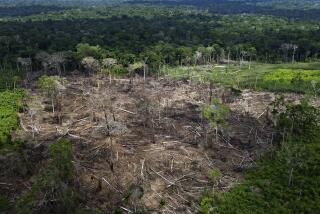Cambodia’s Once-Thriving Rubber Industry Fading Out
- Share via
CHUP PLANTATION, Cambodia — On Cambodia’s oldest rubber plantation, the last remains of a once-great industry trickle slowly from the towering trees.
The bitter scent of latex, which once made great fortunes here, fills the air in the aging forest.
The Cambodian rubber industry, once among the world’s most productive, is collapsing under the weight of poor management, corruption and little investment in new trees, analysts say.
Unless the government revives the industry through privatization, rubber production is expected to dry up within 10 years--an inglorious end for a formerly lucrative export.
In the 1920s, a French financial group known as the Companie du Cambodge started Cambodia’s first rubber plantation on the red soils of Chup.
Other firms soon flocked to Cambodia’s ideal climate, and for many years they produced among the world’s highest yields per hectare (2.4 acres): about two tons, for a total of 200,000 tons of rubber annually, officials say.
But in the aftermath of war and the brutal 1975-79 Khmer Rouge era, the neglected plantations went under state ownership, during which the six state companies planted few new trees.
Today, Cambodia’s aging trees, one quarter of which are more than 40 years old, produce less than 40,000 tons of dry rubber per year from 61,000 hectares (146,000 acres), according to government documents, and yields are expected to drop about 2,000 tons each year.
While 93% of the world’s rubber comes from Asia, Cambodia’s share of the market has dropped to 0.6% of production, according to Commerce Ministry statistics.
At Chup, trees date back to the 1920s, with most at least 40 to 50 years old. This is far beyond the usual 25- to 30-year limit when they are cut and replanted. Additionally, few modern techniques are used.
“If Cambodia continues as it has, in 10 years there will be no more production of rubber,” says one rubber expert.
Most analysts say privatization is the answer for Cambodia’s rubber industry, and international donors such as the International Monetary Fund have recommended it.
At least three companies have tried unsuccessfully to rent state plantations.
“In principle, we have decided to privatize already,” said Kaing Leang Khan, deputy director of state property at the Finance Ministry, but he concedes there has been little progress.
Part of the problem is that most state companies resist the idea.
“In my opinion, we have no need to privatize,” said Mak Kim Hong, director of the state’s Chup Rubber Co., noting that his firm made $3 million in profit in 1996.
As long as plantations remain in government hands, analysts say, little new investment in planting is expected.
While the wood from old rubber trees can fetch $1,500 per ton and its signature white color is highly popular, felling the trees would put about 20,000 rubber tappers out of a job.
State owners would have to wait seven years before new trees could begin to be commercially viable, says Kaing Leang Khan.
Opposition leader Sam Rainsy, president of the Khmer Nation Party and former minister of finance, says corruption is another reason for resistance to investment and privatization.
He thinks state rubber companies should be generating $30 million per year for the government, but notes little has found its way into state coffers.
“Where is the money? Where has it gone? It is not in the state coffers,” he said in an interview.
Officials at the Finance Ministry concede that no rubber money went to the government in 1995 and less than $1 million was received in 1996, though they deny any high-level corruption.
But all officials admit that corruption exists on a small scale. Second Prime Minister Hun Sen has spoken out against people in the countryside notorious for stealing latex at night, and Mak Kim Hong says others seize latex in transit from the plantations.
The lack of movement toward privatization and the dearth of new trees has cast gloom on the industry, say analysts.
The French government spent 28 million francs ($4.4 million) helping to rehabilitate the government’s rubber cultivation, but has since ended the program.
Observers say the French were frustrated with the Cambodian government’s lack of movement on privatization, but the French Embassy declined to discuss the program other than to say it had run its course.
Analysts say the result is that aging trees will soon dry up unless someone is allowed to come in and plant on the estimated 330,000 hectares (792,000 acres) that are considered ideal for cultivation.
More to Read
Sign up for Essential California
The most important California stories and recommendations in your inbox every morning.
You may occasionally receive promotional content from the Los Angeles Times.













